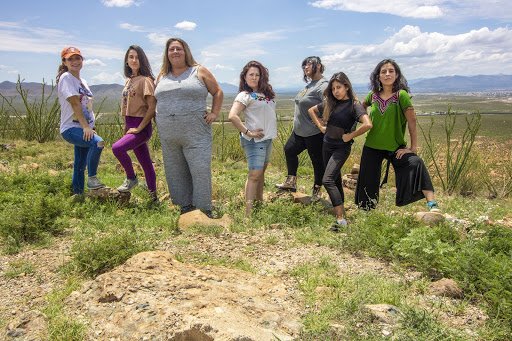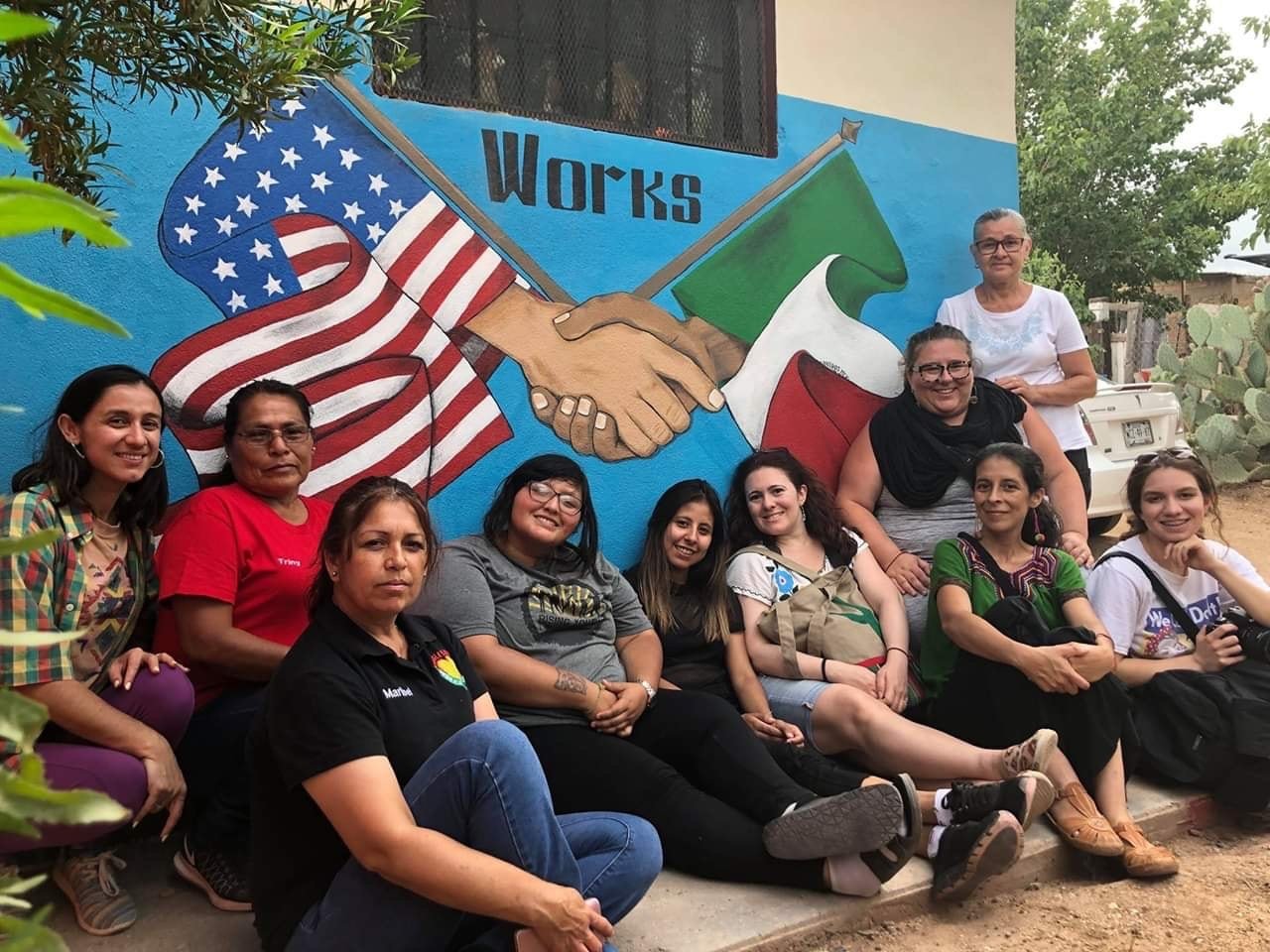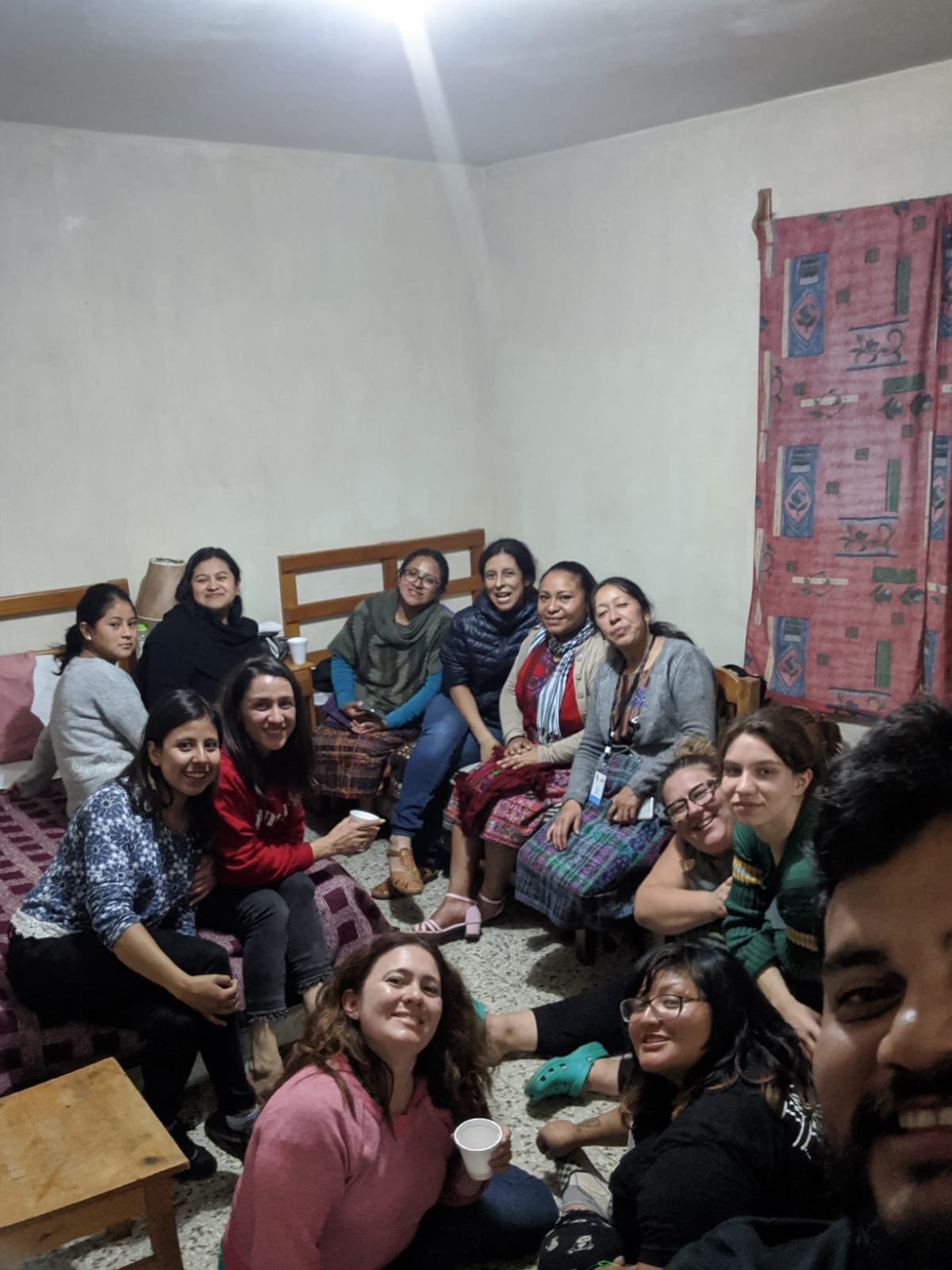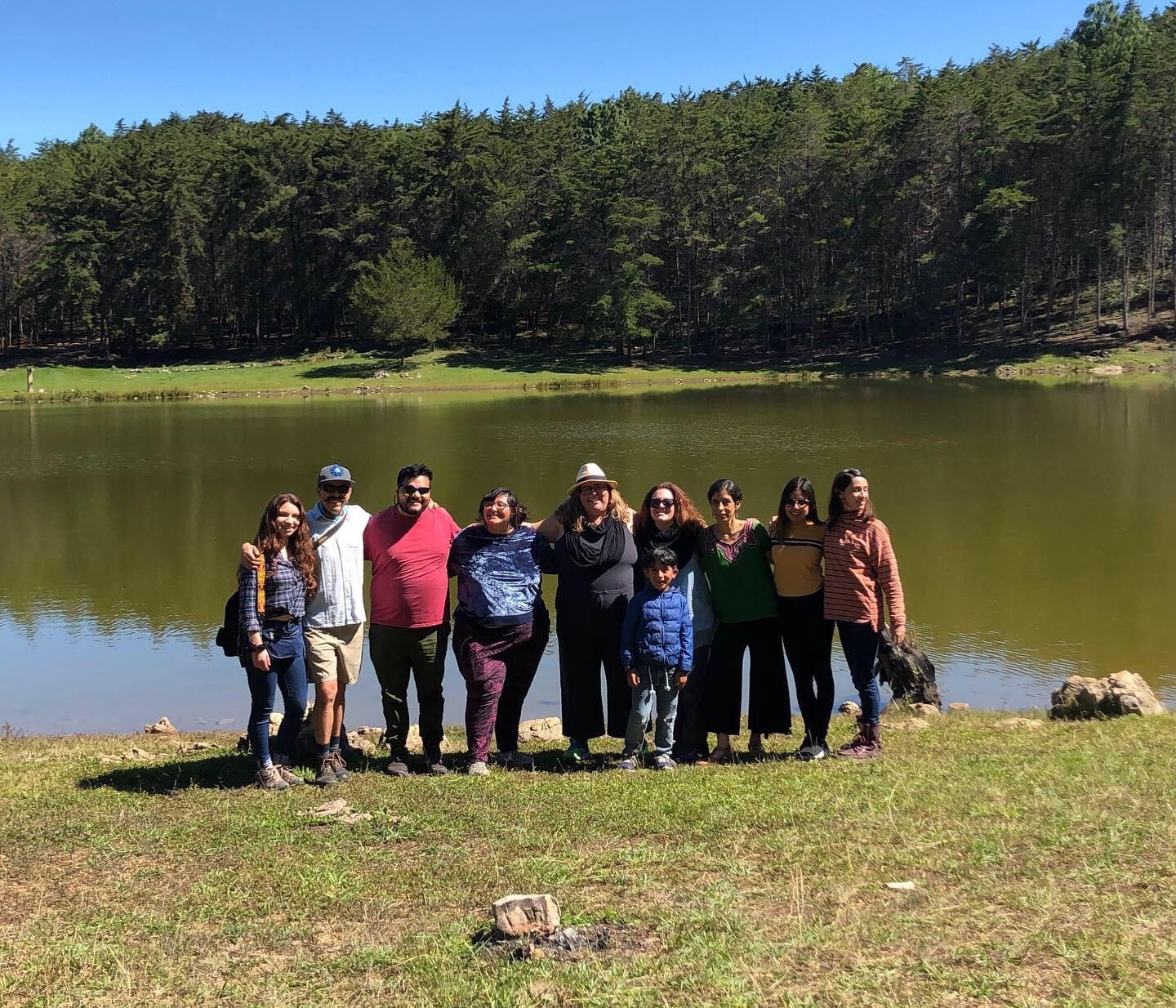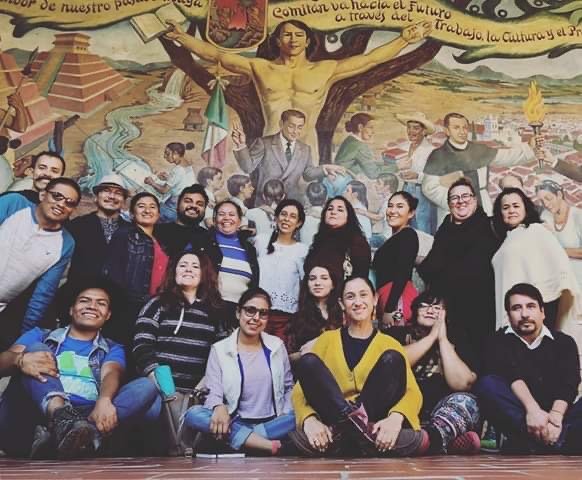NET/TEN Shareback: Rising Youth Theatre - Beginning an Intergenerational, Tri-national Collaboration—Aprendizajes, Consejos, y Ejercisios
Spring 2019 Travel Grant
Rising Youth Theatre (Phoenix, AZ), Safos Dance Theatre (Tuscon, AZ), Border Arts Corridor (Douglas, AZ), Komos Teatro (Sacatepéquez, Guatemala), and independent artist Gabriela Muñoz (Phoenix, AZ) will explore building a site-specific multidisciplinary performance that would take place at both the U.S./México border and the Guatemala/México border, and would be co-created by youth and adults through a community-engaged process. The grant will fund an initial research trip for all partners to spend time in each border region, building relationships with each other.
Yvonne Montoya, Paula Ortega, Ammi Robles, M. Jenea Sanchez, América Tovar, Xanthia Walker
Introduction:
The Las Fronterizas Ensemble is an intergenerational team led by six mujeres artistas from Sonora and Arizona, representing Rising Youth Theatre, Safos Dance Theatre, and Border Arts Corridor. The ensemble works collaboratively across and between borders and art forms. Four of the six mujeres artistas are born and raised in Douglas/Agua Prieta, and all six reside in Arizona/Sonora. Three mujeres are youth ages 17-21 and three are adult 30-somthings. Five of the six mujeres identify as Latinx, and one identifies as White. The work of the Las Fronterizas Ensemble centers the communities of Douglas and Agua Prieta in shaping our own narratives about the border in solidarity with borderlands communities across Arizona, Sonora, and beyond. The ensemble works to honor, celebrate and visibilize the stories of place that shape this binational community.
Through the NET Travel Grant, Las Fronterizas were able to engage in a travel exchange and relationship building experience with Paula Acevedo of Komos Teatro in Sacatepéquez, Guatemala, and her collaborating partners on the Guatemala/México border. The partners visited each other in two trips- Paula Acevedo visited Douglas/Agua Prieta border communities in August of 2019, and Las Fronterizas visited Chaculá/Comitán border communities in November of 2019. Together, we spent time in each border region meeting each other and our collaborators, learning from one another, conviviendo, and engaging in exchanges of our artistic ideas and ways of working and thinking. We explored the possibility of building a site specific multidisciplinary performance through a youth and adult co-created community engaged process that would take place at both the U.S./México border and the Guatemala/México border.
Through this initial relationship building exchange, we have learnings, advice, and a few short scripts for tri-national relationship building to share in reflection of our time together so far. Each of the collaborators in the Las Fronterizas ensemble responded to the questions listed below. Rising Youth collated the responses to build a list of learnings and advice for artists working together to build a collaborative relationship across and between borders of age, national origin, cultural context, and artistic practice.
Aprendizajes:
About Being a Guest and a Host:
As mujeres artistas coming together across multiple communities and cultural contexts, we learned a lot about what it means to be good guests to each other as we are invited into each other’s spaces and communities, and about being good hosts to people we invite into our communities.
MJS: I learned that it is important to not only listen with my ears but also with my body when invited to new spaces. I tried to mark how our host moved in space and take cues from her. I also felt comfortable asking our host questions regarding what may be the best approach or even appropriate in certain moments during the trip. I also learned that it is important to never assume anything as a guest and folks appreciate you taking the time to ask questions and for guidance.
PO: I learned that communication is key to everything . Making sure the guest has eaten, gone to the bathroom and rested well. Making sure our guest feels welcome all the time.
MJS: Being a good host is about making the guest feel cared for and secure in every situation we plan during the trip. I also learned that it is important to make time for downtime, especially in trips meant to generate creative ideas and a connection to place.
XW: It is tempting to pack time together, and to rush the pacing of time and trust. I learned to pause and trust the natural pace of the experience, and to understand that relationships take time to grow, and as we are meeting each other and beginning our exchange, we can’t rush the relationship building and mutual learning. I learned to trust time, instead of rush it.
AR: I learned that in order to be a good host I need to know my city and my people. Also, it’s important to know what is missing from my community as much as I know what is a part of it, so that I can be conscious of how I share my community with other people. It’s also important to know that you can’t know everything and to be a good listener and observer so you can understand what your guests might want or need, and also what you have to share with them.
YM: Take the lead from the host!
About Collaborating Across Multiple Cultural Contexts, Geographies, and Art Forms:
PO: I learned to trust the process even though things may not look smooth to me at first. I got to understand that it's not always about perfectionisms, and I can learn to adapt.
AT: I learned about how sharing my art and listening and learning about the art forms and histories in other places can be connected. I observed how our borders are connected as well, through our stories and how we share so much humanity between our border communities.
YM: I may not understand the cultural norms or practices of different places, and the way artists work or present work and their roles in community is different in all places. Be open and non-judgmental of new experiences and ways of working.
AR: I learned that our communities might be different physically and historically, but at the same time we find connections with each other and our histories, and our origins are connected. We shared values, needs, dreams, suffering, and ideas to build together. This sharing has helped me to feel a connection that transcends borders and inspires me to continue to make art. Co-existing with collaborators from other countries and generations can be a little confusing in relationship to culture, tradition, and point of view, but by entering the experience centering respect and with an open mind, the experience is enriching even when it is challenging.
XW: To embody pluralism- the fact that there are many ways of knowing and being. Never to assume that there is only one right way, and to celebrate the opportunity to exchange ways of knowing through our artistic practices.
PO: I learned that I would love to do more work and have a tool box, to be able to share my art form with anyone, anywhere. I learned that when communities come together they can be so strong.
MJS: My time in Guatemala made me reflect deeply on my connection to my indigenous ancestors. I was deeply moved by the women in the communities we visited, not only for their hospitality, creativity, and openness but also their steadfast commitment to Mayan cultural traditions. The cultural production of the Mayan women is so alive, vibrant, and stable that it made me eager to know more about my own roots and the visuals that helped carry on cultural traditions and oral histories for thousands of years. In modern history, so many of those stories have disappeared or have been severed, especially in my family. I was impressed by the way the Mayan women continue to keep their ancient culture alive in their every day and take pride in doing so.
Consejos:
For Adults and Youth Working Together:
AT:I learned more about what it means to be a good leader, and that everyone can have power in a working space together. Adults in the collaboration shared knowledge and listened to our voices, and demonstrated how our ideas and actions are important to this collaboration.
YM: There are differences in cultural values that are factors in how young people and adults interact in different cultures. It is important to recognize this and also hold space for both/all ways of being without valuing one more than the other, holding space for the multiplicity because both/all forms exists and one is not right or wrong. It is critical for US-based artists not to superimpose a US-based way of young people/adult interactions on other cultures/contexts. It is important to hold space for them and not expect them to conform to US-based methods but rather take a step back and allow them to create ways of collaborating that works best for them.
PO: I learned that communication is important , especially about decision making. Making sure we all agree and are on the same page. That fear of conflict is real and can also be harmful, so understanding and agreeing on boundaries for how we process and debrief together.
MJS: As we are sharing leadership with youth artists, I think we have to be much more intentional about how leadership is shared and be sure to put in the time to debrief as often as possible throughout our process to discuss moments where we can improve as collaborators.
XW: I learned that when we move into new spaces together as an ensemble, it is important to have a process in place for how we will make decisions, debrief concepts, and ensure that everyone has equitable and mutually decided upon space to lead discussions and speak about and for the project. It is on me to check my own privilege and be sure I am not dominating the space.
AR: I learned that direct communication is essential to avoid misunderstandings. A lot of times for us as youth it was sometimes hard to assert our opinion because we grew up with the idea that older people always know more than us. That’s not always true, and for me it was significant that the older mujeres explained that in this group all of our opinions carry the same weight. I also appreciated getting to travel with the older mujeres, because I learned a lot about how to make a trip like this.
For Traveling with Minors and Young Adults:
On our trip, we had minors and adults who were not related traveling together, and people from three different countries. Some of the youth in our ensemble were took their first airplane ride on this trip. Here are some learnings we can share to make international travel with minors feel less daunting:
Call the consulate in each country you are traveling to, and ask for advice on what paperwork is needed in terms of visas, parental permission forms, and temporary guardianship paperwork, etc.
Call the airline to make sure that you have all of the paperwork and permission letters that they require.
Get all of your documents notarized in the country of origin of the youth traveler.
Ensure that no young person has to traverse customs alone. Make sure they have a buddy with them who is comfortable with travel, is over the age of 18, is from the same country of origin as the young person, and is named on their permission letters.
Make a contact list and a detailed itinerary for families to follow along with the trip and know how to get in contact with the group at all times.
Help young people secure access to phone and internet so that they can check in with families.
Ejercicios:
Short Travel-Based Performance Scores for Relationship Building:
Sharing Meals:
Food is something beautiful and can bring communities together. Share meals together as much as possible, and try the following strategies:
Say yes when invited into homes or community spaces to eat
Eat locally, and support the local community when buying food
Invite folks to eat with you whenever possible
Engage in dialogue while eating together
Walk together after eating
Lengthy Car Travel:
Both of the trips we took involved traveling in both rural and urban geographies, and we spent a lot of time in the car together. This proved to be an excellent relationship building tool. Spend a significant amount of time on the road together, and try the following strategies:
Drive in 3 countries, different people drive in each country
Take turns driving when appropriate
Can the ensemble entertain themselves on 10 hours of switchback roads?
Talk
Sing together and play musical instruments
Sleep
Plan the workshops you’ll be a part of when you arrive at your destination
Imagine something together
Process together
Buy every available road side snack and share with the whole car
Get carsick individually and collectively, and share Dramamine
Introduction to Land:
In each space you visit, spend time outside. Ensemble members (in our case Yvonne) can lead the group in an exercise of introduction and listening. This should look different for each ensemble, based on who you are and what your relationship is to each other and the space where you are. See our included video for an example of some of our ensemble’s practice.
Resources:
Border Arts Corridor: www.bacaz.org
Safos Dance Theatre: safosdance.wixsite.com/safosdance
Rising Youth Theatre: www.risingyouththeatre.org
Komos Teatro: https://www.facebook.com/fiestacomunitaria/

